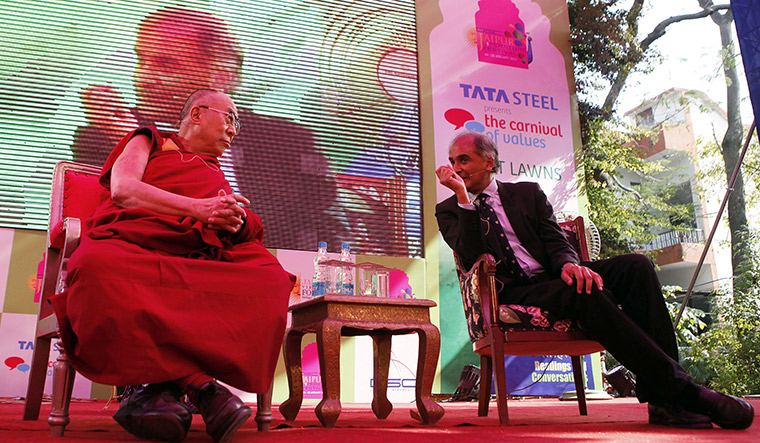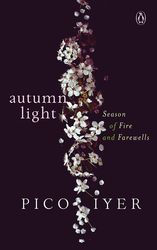It begins with death. But Pico Iyer’s new book, Autumn Light: Season of Fire and Farewells, is about life and living. Hiroko, Iyer’s wife, calls him, telling him her father is in hospital. Iyer is in Florida, where he spends six months looking after his mother, who is in her 80s. His blood is white, she says. Two days later, he dies. Seven years ago, Iyer let readers into his head, writing passionately and lovingly about Graham Greene in The Man Within My Head. In his latest book, he lets readers into his world. The journey is worth it.
Elegant, lyrical, full of wisdom, Autumn Light is Iyer’s homage to Japan, as also a reflection on growing old. It is about acceptance, equanimity and, as everything that Iyer writes, the fragility of life and the overwhelming nature of it. But he does that simply, translating complex emotions into words.
The book is also a love story as Iyer writes sensitively about Hiroko—biker chic, complete with boots and cat cool shades—a believer in rituals and with great faith. It is an ode to her and her spirit. “I have only accelerator. No brake,” she describes herself to a friend of his—a contrast to his stillness. There is the death of his father-in-law; his mother-in-law and her mental confusion, his wife’s grief; his daughter and her battle with Hodgkin’s diesease when she was a child; and his brother-in-law Mashahiro, a Jungian psychologist who cut off all relations when Hiroko divorced her husband and moved to a small flat with her two kids once she met Iyer. The book is as much a portrait of this family grappling with the loss as it is about love.
It was autumn when he, a 26-year-old, first got “upended by Japan” only to realise that “not to live here would be to commit” to a “kind of exile for life”. His encounter and fascination with Japan resulted in The Lady and the Monk. Over three decades later, Iyer returns to Japan again. This time, older and wiser, he captures its calm. “Cherry blossoms, pretty and frothy as schoolgirls’ giggles, are the face the country likes to present to the world, all pink and white eroticism, but it is the reddening of the maple leaves under the blaze of the ceramic-blue skies that is the place’s secret heart,” writes Iyer. He uses autumn—think Keats, the beauty before the decay—to talk about life.
The book is about his relationship with a country where he now lives, his friends, his ping-pong game—he goes to the club every day playing 80-year-olds who are sharp and talented—and his family. This is the first time that readers see his world in Japan. If The Lady and the Monk brought to the fore the mysterious and fascinating side of Japan, the sequel bares its soul. Sadness, sometimes, lasts longer than “mere pleasure”, and Iyer uses his daily life to make this point.
Iyer has, over the years, gone beyond being a travel writer to become a philosopher. His writing is at the heart of why anyone begins a journey—to grow. At the end of the book, it is like meditation, an ocean of calm. “Now I see it is in spaces where nothing is happening that one has to make a life,” says Iyer to his wife. To which, she responds “Little no-action movie.” Iyer tackles in the book what Buddha grappled with—old age, death and sorrow. It is Buddhist philosophy 101. But when Iyer writes, it is not trite.
Edited excerpts from an interview:
You are on Twitter. You stayed away from technology and resisted a smartphone for years. How does someone like you who has mastered the art of stillness manage to stay sane on Twitter, which, in a way, epitomises chaos?
I must confess, almost with embarrassment, that I have still never used a cellphone, don’t know what Facebook is, exult in living in Japan without a car (or bicycle) or any kind of media, and am not really a fan of communicating in 140-character bursts. However, six years ago, when I was preparing to do my first talk for TED, the always gracious and far-sighted organisers of TED pointed out that 66 of the 80 speakers in that meeting were on Twitter. I felt so ashamed that I instantly signed up, only to find that I have nothing to say!
So, I simply post one tweet a day, as much as many of my heroes (the Dalai Lama, say) do, and I am afraid I am too incompetent even to know how to answer a tweet, or retweet, or do anything else. When I first joined, I inadvertently followed two or three people, but in truth I have never read a tweet, except when it is included in an article. So tweeting takes around 10 to 15 seconds a day, and the rest of my 23 hours and 59 minutes and 45 seconds I can live in peace.
While you have written about your family and life in previous books, your new book is far more personal. Was writing this book tougher?
It doesn’t feel to me like my personal book, though it is indeed the first book I have written from that part of me that goes about a daily life in Japan and is seen by my neighbours as a “parasite” (to use the nickname the local kids have for me).... To me the book is full of everyday details about my life, but in some ways it is less personal than other of my books because it is not so much about my inner passions, my ideas, my vision.... And, the book was very hard to write only because I was trying to distil 32 years of emotions, experiences and encounters into a very short text that was mostly silences and absences.
Luckily, I have another book on Japan—almost contradictory in every way—coming out in September that will show you a very different side of the country (everything from its love-hotels to its baseball stadia, its fashion-victim trains to its temple gardens).
Beliefs and rituals form a large part of the book. How would you define your spiritual practice? You once said that you are not a Buddhist, but “just another tourist peering through the glass window and catching at reflections”. You talk about stillness, but don’t meditate.
I would say my religious life consists only of the belief that there is more going on in the world than I can explain, dark and light, and that I determine much less of my life than I sometimes like to imagine.
I have never been part of a religious order, and, as you say, I don’t meditate. But the kindest and most grounded people I know are the ones with a strong religious commitment.... I travel to learn, and the most important things I can learn are about how there are more things on heaven and earth than are dreamed of in our philosophy. How the world will always be larger than our explanations. And, how each of us is a point of light surrounded by an immense darkness that we can’t begin to fathom.
So, when I want to learn about tennis, I watch Roger Federer, and when I want to learn about writing, I read Alice Munro. When I want to learn about life and love and loss, I turn to monks, who are professionals in the business of understanding and take the mind and its illusions apart. That is one reason why I spend so much time with the Dalai Lama, unparalleled in his command of kindness and attention, and why I spend so much of the rest of my time in a Benedictine monastery in California and among the temples of Japan. I want to learn from the pros!
One of the aspects of the book, especially when you write about your ping-pong playing, is kindness. Do you feel it is threatened today? How can we hang on to it?
You put your finger on the very heart of the book. Whenever people ask me why I choose to live in Japan, I answer—kindness. Japan is the centre of a selflessness, a thoughtfulness, an instinctive compassion that moves and silences me every hour. When you meet a Japanese person, all her emphasis is on what you need, what you are saying, what you are trying to share, not on what she wishes to advance or inflict. And, therefore, those of us who visit Japan try to learn how to extend the same kind of courtesies in return.
We are all aware that modesty and empathy are under threat right now, as Pope Francis pointed out so beautifully. I put a lot of faith in imagination, which is all about looking over walls and dissolving borders, and in travel, which is about refusing to take in the world through screens (which is to say, images and stereotypes and assumptions) and seeing it first-hand in all its human complexity.
I am teaching at Princeton right now—my first time in a classroom in 37 years—and I am stunned at how the students I have come to know well don’t think in terms of black and white. They genuinely feel their responsibilities are global, and that sex trafficking in Nepal or AIDS in southern Africa are as much their concern as those same problems in New York city....
So long as young people like this... can see beyond binaries and take the entire world as their neighbourhood, there is hope. We will never be without tribalism and division and some of the intolerance we see everywhere these days, but that doesn’t mean we are not moving forward.
AUTUMN LIGHT: SEASON OF FIRE AND FAREWELLS
Author: Pico Iyer
Publisher: Penguin Random House
Pages: 236
Price: Rs 599




